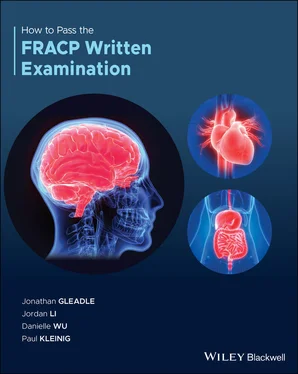Based on its size, a pituitary adenoma can be classified as a microadenoma (<10 mm diameter) or a macroadenoma (>10 mm diameter). Approximately 50% are microadenomas. Prolactinomas are the most common hormone‐secreting pituitary tumours accounting for 32 to 66% of adenomas. Symptoms and signs of prolactinomas are shown in Table 4.2. Female patients usually have small prolactinomas at diagnosis because the symptoms of galactorrhoea and amenorrhoea result in an early presentation. Patients may present with headaches which can have variable quality and location due to stretching of the dura.
Table 4.2 Clinical features for prolactinoma.
| Female clinical features |
Male clinical features |
Both male and female features |
| Galactorrhoea |
Hypogonadism |
Headache |
| Amenorrhoea |
Reduced libido |
Visual field deficit |
| Infertility |
Erectile dysfunction |
Osteoporosis |
|
Gynaecomastia |
|
|
Infertility |
|
Laboratory investigations for suspected prolactinoma include the following:
Serum prolactin level and macroprolactin level if clinically needed
Serum pregnancy test
Serum TSH
Serum testosterone or bioavailable testosterone: In males presenting with symptoms of hypogonadism
Basal cortisol level and short Synacthen test in patients with a history suggestive of adrenal insufficiency or any patient before surgery
Renal function tests, impaired renal function can lead to impaired prolactin clearance.
After performing biochemical and hormonal tests, MRI or CT head with contrast is used to determine if a mass lesion is present. If no mass lesion is present, it is also important to note that prolactin may be elevated due to a range of medications, including dopamine antagonists such as antipsychotics, drugs that affect gastric motility such as metoclopramide and domperidone and certain antihypertensives such as methyldopa.
Patients with pituitary adenomas should be identified at an early stage so that effective treatment can be planned. For all other pituitary adenomas, initial therapy is generally transsphenoidal surgery with medical therapy being reserved for those not cured by surgery. For prolactinomas, treatment is indicated if mass effects from prolactinoma and/or significant effects from hyperprolactinemia are present. The initial therapy is generally dopamine agonists, which not only decrease the synthesis and secretion of prolactin but also the rate of tumour cell division and the growth of individual cells. Cabergoline, an ergot derivative, is a long‐acting dopamine agonist. It is usually better tolerated than bromocriptine and its efficacy profiles are superior to bromocriptine. It offers the convenience of twice‐a‐week administration, with a usual starting dose of 0.5 mg. Bromocriptine is an ergoline derivative and dopamine agonist. It had been used in the treatment of prolactinoma because of its long track record and safety. In macroprolactinomas, bromocriptine treatment results in some reduction of tumour size in up to 80–85% of the patients.
Transsphenoidal pituitary adenomectomy is the preferred surgical treatment in patients with macroprolactinoma and patients with microprolactinoma who fail to respond to medical treatment. A combination of surgery followed by postoperative medical treatment with bromocriptine or one of the other agents is used in patients with incomplete resolution of elevated prolactin levels and in patients with residual tumours seen on follow‐up imaging studies.

Molitch ME. Diagnosis and treatment of pituitary adenomas A Review. JAMA. 2017;317:516–524.
https://jamanetwork.com/journals/jama/article-abstract/2600472
24. Answer: D
Two types of continuous glucose monitoring (CGM) systems are now available: real‐time CGM (rtCGM) and intermittently scanned CGM (isCGM). Current rtCGM system automatically transmits a continuous stream of glucose data (trend and numerical) in real time to a receiver, smart watch, or smartphone and provides alerts and active alarms. The current isCGM system provides the same type of glucose data but requires the user to purposely scan the sensor to obtain information and does not have alerts and alarms. CGM systems provide continuous measurement at 1–5 min increments of glucose concentrations in the interstitial fluid, which correlate with blood glucose levels. The lag time between the interstitial fluid glucose measured by rtCGM and plasma glucose is a limitation to the real‐time actionable data provided by devices. Moreover, all current systems for rtCGM are less accurate in the lower glucose ranges but are improving in this regard.
Numerous recent studies have demonstrated the clinical efficacy and other benefits of rtCGM use in individuals with type 1 diabetes (T1D) and type 2 diabetes (T2D) regardless of the insulin delivery method used. There is a modest reduction in HbA1c. rtCGM reduced the time spent in the hypoglycaemic (T1D only) and hyperglycaemic ranges and demonstrated reductions in moderate to severe hypoglycaemia in individuals with T1D and T2D compared with traditional self‐monitoring of blood glucose (SMBG).
Recent studies have also demonstrated the benefits of rtCGM as an integrated component of sensor‐augmented insulin pumps with predictive low glucose suspend functionality. Automatic insulin pump suspension can help individuals with T1D avoid hypoglycaemia without significantly increasing hyperglycaemia or the risk of diabetic ketoacidosis. Guidelines recommended the use of rtCGM in individuals with recurrent severe hypoglycaemia and/or impaired hypoglycaemia awareness. The beneficial effects of rtCGM use have not only been shown in poorly controlled T1D, but also in individuals who have achieved good control, by reducing glycaemic variability.
Individuals who could benefit from data sharing capability (e.g. paediatric patients, the elderly, patients with mental health illness and patients who travel alone) are also good candidates for rtCGM. Other candidates for rtCGM use include individuals who have a high HbA1c, are physically active, want to use insulin pump systems that offer predictive low glucose suspend functionality, experience hypoglycaemia fear, or desire tighter glucose control than obtained with their current monitoring system.
In summary, based upon the current evidence, use of rtCGM is now recognised as the standard of care for individuals with T1D and a subset of those with insulin‐requiring T2D.

Edelman S, Argento N, Pettus J, Hirsch I. Clinical Implications of Real‐time and Intermittently Scanned Continuous Glucose Monitoring. Diabetes Care. 2018;41(11):2265–2274.
https://care.diabetesjournals.org/content/41/11/2265.long
25. Answer: D
Multiple side effects have been identified for treatment with SGLT‐2 inhibitors, including those listed as answer options as well as bone fracture. However, individual trials lack the power to detect significant differences in these rare adverse outcomes. As a result multiple meta‐analyses have been performed with the intention of clarifying these post‐marketing observations. The most recent of which showed no overall difference in fracture, or UTI – except that dapagliflozin alone independently increases the risk of UTI. Despite some reports, SGLT‐2 inhibitors are strongly protective against AKI and recent evidence suggests it is protective against progression of chronic diabetic kidney disease. DKA can occur in the setting of acute physiological stress without hyperglycaemia when treated with SGLT‐2 inhibitors, but the overall rate of DKA is not greater in treated patients. There is some suggestion that SGLT‐2 inhibitors may increase the risk of limb amputation, although meta‐analysis of available trial data is significantly underpowered to draw this conclusion, and absolute risk is very low.
Читать дальше














